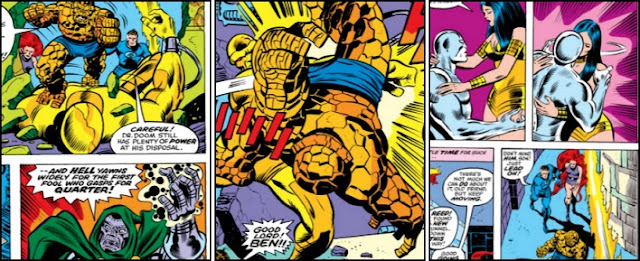 |
| FANTASTIC FOUR No. 157, April 1975 |
Considering it contains the super-powered quartet’s most
formidable foe, Doctor Doom, a cataclysmic fist-fight with the Latverian
Monarch’s “new, improved and deadly Doomsman”, and prominently features Jack Kirby’s
ever popular Silver Surfer, this particular issue of “Fantastic Four” could
arguably be, as its cover proudly proclaims, “The World’s Greatest Comic
Magazine!”… If only it didn’t also
include one of Editor Roy Thomas’ clunkiest and poorly written scripts.
Admittedly this dramatic conclusion to yet another of the
“dysfunctional, yet loving” family’s frequent battles with Victor Von Doom
starts excitingly enough. For having fed “a giant android of my own creation”
with Norrin Radd’s Power Cosmic, and provided the readers with a wonderfully
corny yet sinister soliloquy, the armoured sorcerer pits his “impressive”
automaton against all four members of Stan Lee’s first superhero team in an
action-packed slugfest.
Unfortunately however, almost as soon as the punch-up begins, Thomas brings it to an abrupt conclusion by having ‘the
Silver Surfer enter the fray’ in order to ensure that “the scales may be tipped”,
and leaves an enraged Doctor Doom, single-handedly facing his greatest enemies; “It’s clobberin’ time!” Sadly such a mouth-watering one-verses-five contest never materialises though as the story’s love interest for Galactus’
former herald, Helena, implores them to stop fighting before the “rebuilt” Latverian
castle is destroyed along with all the “priceless… archives and artifacts
from all over the kingdom”.
Considering how manically murderous the fighting had been
just moments before, such a flimsy excuse for a truce seems highly unlikely.
Yet staggeringly, Reed Richards uses it to justify a ceasefire and suggests to
his arch-nemesis that he “Let us go in peace, and we’ll call it a stalemate --
til we meet you again in some neutral court.” To make matters worse, the ‘Third
Greatest Comic Book Villain of All Time’, as voted by “Imagine Games Network”, meekly agrees to such a dissatisfactory conclusion with a petulant “Yes -- All right”,
and lets his adversaries simply walk out of his stronghold.
Disappointingly, such an apathetic resolution to so
promising a confrontation isn’t the end of this narrative however, as the
Jackson-born writer ‘bolts on’ a truly bizarre three-page sequence depicting
Mephisto, “truly the wisest of all”, informing one of his “humble minions” that
he was actually behind Doctor Doom’s battle with the Fantastic Four. This
additional scene makes little sense whatsoever, as the “Lord of Evil” reveals
how he inexplicably hates the Silver Surfer “more than any” other being, and in
order to punish the sky-rider banished “his beloved long-lost Shalla-Bal” not
to her native planet Zenn-La but to Latveria, “where I gave her a new layer of
memory over the old” and ‘created’ Helena. Overly complicated, convoluted, and nonsensical,
it is clear why Thomas required the additional help of Len Wein as his “unindicted
co-conspirator”, in order to fashion together such an uninspiring storyline.
 |
| Writer/Editor: Roy Thomas, Artist/Illustrator: Rich Buckler, and Inker/Embellisher: Joe Sinnott |

Sadly this is often the case with silver age "Marvel" where things don't match up to either the front page hype and the story itself's build up. You almost get the feeling sometimes that the writers were somewhat "neutered" by something (was this issue during the comic code debacle?). Or did they just come up with these huge ideas without the time or dare I say "talent" to fully exploit the concepts?
ReplyDeleteCheers Roger.
This comic came out just after the Comics Code Authority had actually been revised a number of times during the early Seventies, Roger. SO I think its far more likely a case that Roy Thomas probably had enough ideas for a two and a half issue storyline, and employed Len Wein to stretch it to the full three issue narrative. I don't have (that I'm aware of) #155 and #156, so I'm uncertain as to how clunkily written they are.
Delete